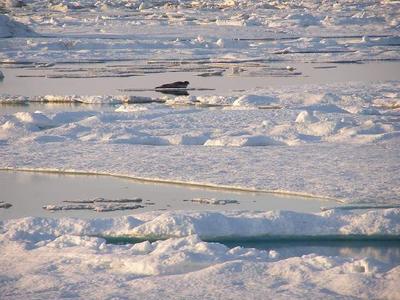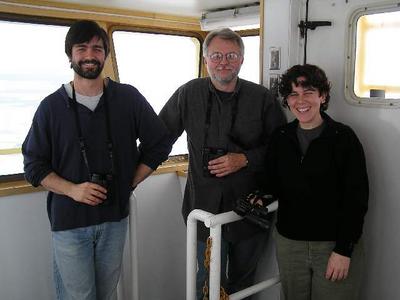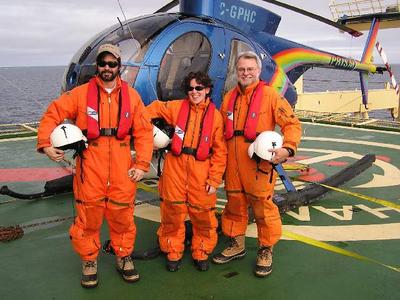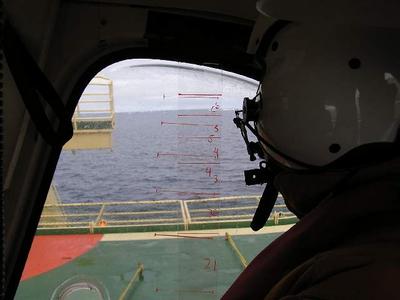
|
|
14 August, 2003
Much of the focus of this cruise has been on what's below the
surface. The scientists on board are primarily interested in
chemical and physical properties such as dissolved oxygen, salinity,
temperature, chlorophyll, and nutrients in the seawater. There is
one exception, however, as everyone loves the mammals, and seeing
polar bears, walrus, and whales is a high priority for many aboard.
Indeed, when word gets out that a bear is near, phones ring, radios
call, doors knocked, and before you know it, a crowd of wildlife
watchers have gathered on the Palmer's bow with cameras and videos in
hand.
So I was somewhat puzzled by one observer's comment to my
enthusiastic heads-up, "look, there's a seal!" A short pause later,
his response was simply "how about a bear?" "No, I don't see any," I
chuckled, "although the bearded seal at two o'clock on the starboard
side is pretty cool." But my companion on the Palmer's bow wanted
bears, for after all, as he logically noted, "Bears eat seals, so
there must be one around nearby." And that's how it went for much of
the trip whenever seals were sighted. Responses often ranged from a
respectful "oh, really?" to an indifferent "that's nice."
Perhaps I exaggerate a little bit, for there are three people in
parcticular that are very, very, very interested in seeing seals - or
at least in counting them. Actually, the three scientists of the
Marine Mammal Survey Team really love these hairy flippered
pinnipeds. So much so that two of them have largely made the study
of seals and their kin their life's work and the third may do the
same.
Dr. John Bengtson of the National Marine Mammal Laboratory has been
researching the ecology and behavior of marine mammals for nearly 30
years from Antarctica and Central America to Florida and the Arctic.
By chance, I happened to come across a photograph up on the bridge
that showed John as the Chief Scientist during an Antarctic cruise on
the Palmer not long ago. Needless to say, this guy gets around, and
he is well known and highly respected among marine mammal scientists.
Recently he gave a presentation to many of us on board about his work
on Antarctic seals. John's pictures, research, and humorous
anecdotes made for a highly interesting and entertaining program.
And John's sharp eye for spotting seals helped him as well to spot
the cruise's first Ivory Gull, the significance of which is explained
in the journal entry for the first of August.
Dr. Mike Cameron, also with the marine mammal lab in Seattle,
Washington, has been working with seals and their population dynamics
for the past 11 years. Until now, all of Mike's previous research
was in Antarctica where he found it easier to study seals. For one,
he explained, Antarctic seals do not have to worry about polar bears;
in fact, they are most vulnerable when they are in the water where
Leopard Seals and Orcas are the top predators. And unlike their
northern counterparts, Antarctic seals have largely not been hunted
by humans. This enabled Mike to walk right up to a seal, which of
course, greatly facilitated his work. Still, after just a few
minutes of visiting with Mike about his current project, it's easy to
share in his excitement for having this opportunity to study marine
mammals in the Arctic which he intends to do for the next few years.
Heather Smith, a graduate student in Dr. Glenn VanBlaricom's
laboratory at the University of Washington, completes the marine
mammal team. Although she is technically only a student, Heather
brings a wealth of field experience to the team. She assisted in a
marine mammal survey for the Marine Mammal Research Group in
Victoria, BC, for example, and later radio-tracked manatees in
southern Florida. Heather also spent a field season on Midway Island
where she assisted with the tagging, radio-tracking, and population
monitoring of Hawaiian Monk seals as well as research on the
reproductive success of various seabirds. After that, Heather
studied fat. Well, blubber, really. Heather recently completed her
Master's degree at Texas A&M University where she examined the fatty
acid composition of Common Dolphin blubber. There's an old saying
that goes "you are what you eat," and that seems to hold true for
marine mammals. By studying the fatty acids in their blubber, it may
be possible to determine what these creatures have been feeding on.
Heather plans to complete a similar analysis on samples of Beluga
blubber that she collected last summer in Point Lay, Alaska. When
she returns to school after the cruise, this highly talented wildlife
biologist hopes to develop a research project examining the food
habits of ice seals.
How do these adventurous wildlife biologists study seals? According
to John (in his words) the most effective way to conduct this work is
by flying aerial surveys from the helicopter aboard the Palmer.
Surveys are flown during mid-day (2 hours either side of local noon)
when the greatest proportion of seals are expected to be hauled out.
As conditions allow, helicopter survey tracks are set out
perpendicular to bathymetric and sea ice gradients, which are thought
to influence seal distribution. An observer positioned at each of
the windows on the right and left sides of the aircraft counts seals
seen during the flight Perpendicular distance of seals from the
survey line is measured by sighting along six fixed 10 degree
vertical angles (0 degree - 60 degree from the horizon in 10 degree
increments) on a Plexiglas strip attached to the helicopter's window.
The perpendicular distance interval is then computed from the
helicopter's altitude and the assigned angle category. The area
beneath the aircraft (60 degree- 90 degree) is not visible to the
observer, so this survey strip is monitored by a downward-looking
digital video recorder. When weather conditions are not suitable for
flying, we can also conduct surveys from the Palmer's ice tower as
the ship moves through the pack ice.
And exactly what are they looking for, and why? John goes on to
explain: The shelf, slope, and basin zones of the western arctic
provide productive habitats for polar marine mammals. Determining
the seasonal patterns of seal and whale abundance and distribution is
the key to understanding the ecological interactions involving these
apex predators and the ecosystem "hotspots" where they are often
found. Different marine mammal species integrate the environment
across variable spatial and temporal scales, with the composite
result reflecting oceanographic primary and secondary productivity
derived from transport processes and mesoscale oceanographic
features. Although abundance and distribution data on all marine
mammal species observed is being recorded, our main focus is on two
species of seals in the sea ice zone: Bearded Seals (benthic
foragers), and Ringed Seals (fish and crustacean predators). Our
principal research objectives are to determine marine mammal
distribution, relative abundance and habitat associations via visual
surveys, and to relate these patterns with measures of oceanographic
structure and potential prey availability.
So certain species are found in parcticular environments at various
times of the year. And that is what they have seen: bearded seals
(bottom feeders) above the continental shelf in relatively shallow
water, for example, while ringed seals have been in the deeper water
where the shelf drops-off steeply into the ocean basin. Perhaps the
most surprising aspect of their surveys has been the lack of ice.
This doesn't bode well for the sealsí future if the melting
continues, or for that matter, bears and any species that are adapted
to the ice, which is all the more reason for scientists to get a
handle on what's going on up here. From what I have seen, intrepid
scientists like John, Mike, and Heather are surely up to the task.

1. Bearded Seal.

2. Bearded seal biologists- save one- up in the Palmer's Ice Tower.

3. From left to right, Mike, Heather, and John suited-up and ready to fly.

4. Note sighting increments on helicopter window.

5. Heather, Mike (seated), and John in the Dry Lab scanning the digital video tapes and checking-out equipment.
Contact the TEA in the field at
.
If you cannot connect through your browser, copy the
TEA's e-mail address in the "To:" line of
your favorite e-mail package.
|
